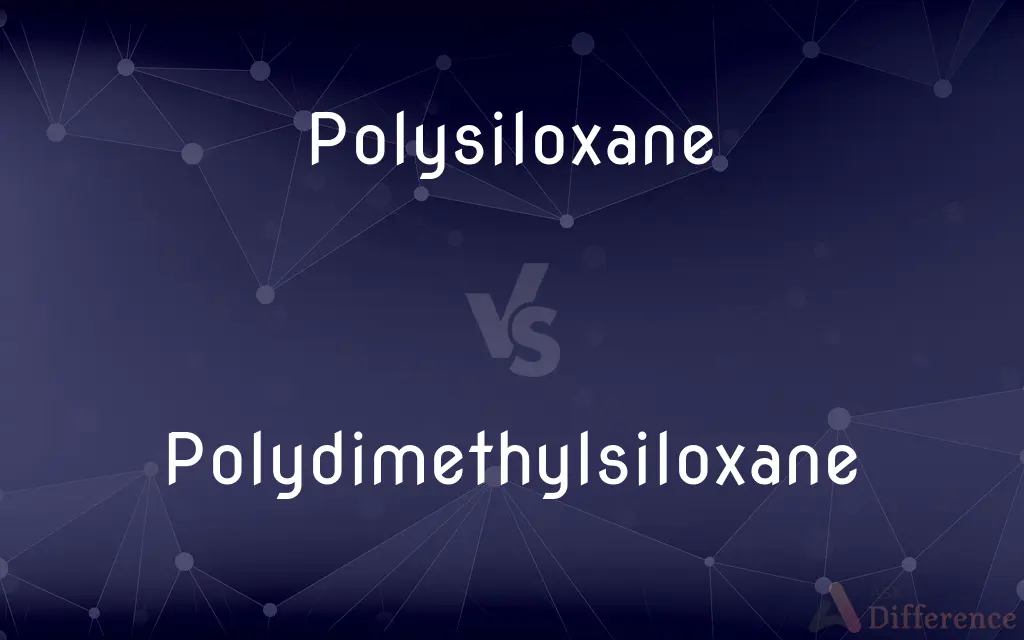Polysiloxane vs. Polydimethylsiloxane — What's the Difference?
Edited by Tayyaba Rehman — By Urooj Arif — Updated on April 18, 2024
Polysiloxane refers to a group of polymers featuring silicon-oxygen backbones, while polydimethylsiloxane (PDMS) is a specific type of polysiloxane with two methyl groups attached to each silicon.

Difference Between Polysiloxane and Polydimethylsiloxane
Table of Contents
ADVERTISEMENT
Key Differences
Polysiloxanes are a broad class of polymers known for their silicon-oxygen chain structures, which provide notable flexibility and thermal stability. Polydimethylsiloxane, on the other hand, is a specific member of this family, characterized by its repeating Si-O-Si units with two methyl groups (-CH3) attached to the silicon.
The general properties of polysiloxanes, such as chemical inertness, non-toxicity, and resistance to weathering, are exemplified in PDMS, which also displays exceptional low-temperature flexibility and low surface tension.
While polysiloxanes can vary widely in terms of molecular structure and functional groups leading to diverse applications, PDMS is particularly noted for its use in lubricants, hydraulic fluids, and biomedical applications, due to its specific physical and chemical properties.
The versatility of polysiloxanes allows them to be modified into various forms including resins, elastomers, and fluids. In contrast, PDMS is commonly utilized in its fluid or elastomeric forms, making it a popular choice in industries requiring stable, high-performance materials.
Polysiloxanes, as a class, are used in a wider range of applications due to their ability to be tailored during synthesis. PDMS, while versatile, is particularly renowned in sectors requiring materials with high dielectric strength, thermal stability, and low toxicity.
ADVERTISEMENT
Comparison Chart
Chemical Structure
Silicon-oxygen backbone
Silicon-oxygen backbone with CH3 groups
Common Forms
Resins, elastomers, fluids
Mainly fluids and elastomers
Applications
Vast, depends on side groups
Lubricants, adhesives, medical devices
Thermal Stability
Generally high
Very high
Specific Properties
Diverse, based on structure
Low surface tension, high flexibility
Compare with Definitions
Polysiloxane
They are ideal for applications requiring long-term stability.
Polysiloxane seals are used in construction for their longevity.
Polydimethylsiloxane
Known for its extremely low surface tension and high flexibility.
PDMS coatings are used to create water-repellent surfaces.
Polysiloxane
A group of polymers with a silicon-oxygen backbone, known for their durability.
The bridge was coated with a polysiloxane-based paint for enhanced weather resistance.
Polydimethylsiloxane
A specific type of polysiloxane used widely in medical and cosmetic fields.
PDMS is a primary component in contact lenses for its oxygen permeability.
Polysiloxane
Polysiloxanes vary in properties and uses based on their chemical composition.
Specialty polysiloxane coatings are applied on cars for a glossy finish.
Polydimethylsiloxane
Biocompatible and non-toxic, ideal for biomedical applications.
PDMS is utilized in implants due to its compatibility with body tissues.
Polysiloxane
These polymers are adaptable to various modifications for specific uses.
Modified polysiloxanes are employed in cosmetic products for a smooth texture.
Polydimethylsiloxane
Often used in the form of a lubricant or hydraulic fluid due to its stable properties.
PDMS-based lubricants ensure smooth operation in machinery.
Polysiloxane
Used in making flexible and heat-resistant materials.
Polysiloxane elastomers are used in kitchen spatulas that withstand high temperatures.
Polydimethylsiloxane
Features excellent dielectric properties, making it suitable for electrical insulations.
PDMS is used in underwater cables to prevent water ingress.
Polysiloxane
(chemistry) Any of many polymers having a siloxane repeat unit
Polydimethylsiloxane
Polydimethylsiloxane (PDMS), also known as dimethylpolysiloxane or dimethicone, belongs to a group of polymeric organosilicon compounds that are commonly referred to as silicones. PDMS is the most widely used silicon-based organic polymer, as its versatility and properties lead to many applications.It is particularly known for its unusual rheological (or flow) properties.
Polydimethylsiloxane
(chemistry) The simplest silicone, being a polymer having a repeat unit of -Si(CH3)2-O- ; its properties depend on the degree of polymerization and range from that of an oil to a plastic
Common Curiosities
What are the common uses of polysiloxanes?
They are used in applications ranging from automotive paints to medical devices.
Can polysiloxanes be used at high temperatures?
Yes, they are excellent for high-temperature applications due to their thermal stability.
What makes polysiloxanes resistant to environmental degradation?
Their silicon-oxygen backbone imparts exceptional resistance to UV light and weathering.
Why is PDMS particularly used in medical applications?
Due to its biocompatibility, stability, and safety.
How is PDMS different from other polysiloxanes?
PDMS specifically has two methyl groups attached to each silicon atom.
What is the role of PDMS in healthcare?
PDMS is used in a variety of healthcare products, including tubing, devices for drug delivery systems, and implants, due to its biocompatibility and stable chemical properties.
How do the thermal properties of polysiloxanes compare to other polymers?
Polysiloxanes generally have superior thermal stability and can operate over a wider temperature range compared to many organic polymers, making them suitable for high-temperature applications.
What defines a polysiloxane?
A polymer characterized by its silicon-oxygen backbone.
Are there any environmental concerns associated with the use of PDMS?
While PDMS is considered non-toxic and inert, its persistence in the environment can lead to accumulation, thus requiring careful management in terms of disposal and usage.
How does the structure of PDMS affect its physical properties?
The presence of methyl groups on the silicon atoms provides PDMS with remarkable flexibility and low intermolecular forces, which contribute to its unique properties like low surface tension.
What are the key differences in the molecular weight of polysiloxanes and PDMS?
Molecular weights can vary widely in polysiloxanes depending on the polymerization process, whereas PDMS typically has a more controlled range of molecular weights, influencing its viscosity and mechanical properties.
How does PDMS enhance the performance of cosmetics?
PDMS's smooth texture, non-greasy feel, and ability to form a breathable barrier make it an excellent additive in cosmetic formulations, enhancing spreadability and adding a silky finish.
Can polysiloxanes be customized for specific industrial applications?
Yes, by modifying the side chains and crosslinking density during synthesis, polysiloxanes can be engineered to meet specific requirements of flexibility, durability, and resistance in various industrial applications.
Share Your Discovery

Previous Comparison
Constable vs. Detective
Next Comparison
Ploy vs. RuseAuthor Spotlight
Written by
Urooj ArifUrooj is a skilled content writer at Ask Difference, known for her exceptional ability to simplify complex topics into engaging and informative content. With a passion for research and a flair for clear, concise writing, she consistently delivers articles that resonate with our diverse audience.
Edited by
Tayyaba RehmanTayyaba Rehman is a distinguished writer, currently serving as a primary contributor to askdifference.com. As a researcher in semantics and etymology, Tayyaba's passion for the complexity of languages and their distinctions has found a perfect home on the platform. Tayyaba delves into the intricacies of language, distinguishing between commonly confused words and phrases, thereby providing clarity for readers worldwide.














































